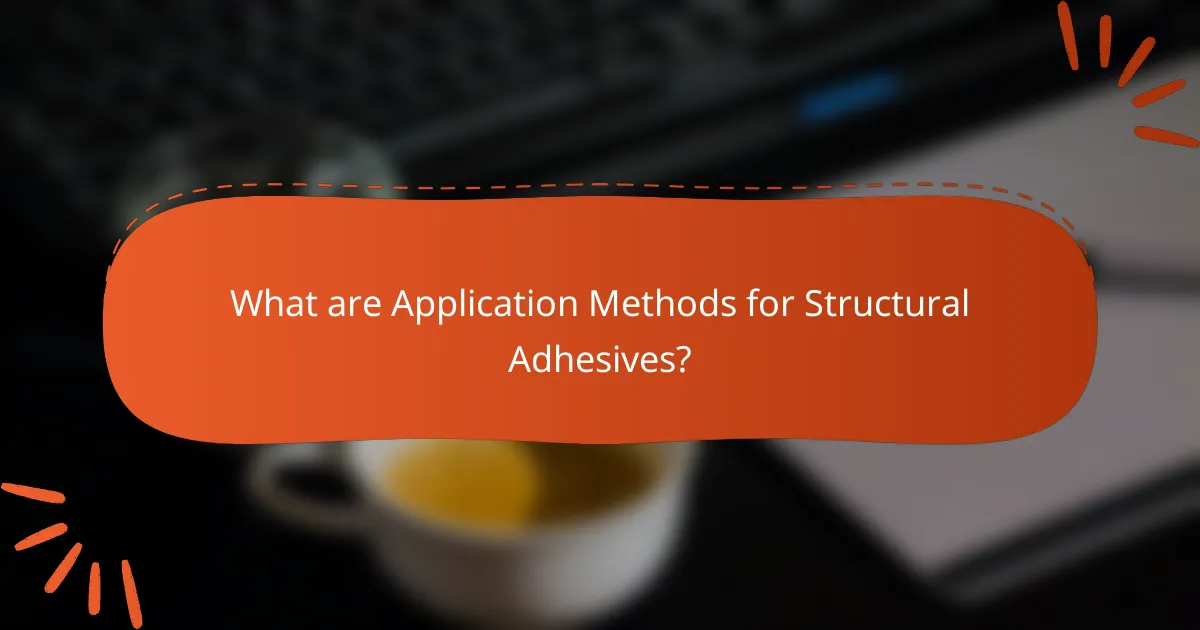Structural adhesives are critical for bonding materials in various applications, and their effectiveness is influenced by the application method used. This article examines different techniques for applying structural adhesives, including manual application with brushes or rollers, automated dispensing for precision, and spray application for large surface coverage. Each method impacts the adhesive’s performance, bond strength, and curing time. Key considerations include efficiency, waste reduction, and the flexibility needed for complex designs, highlighting the importance of selecting the appropriate application method to achieve optimal results.

What are Application Methods for Structural Adhesives?
Application methods for structural adhesives include various techniques such as manual application, automated dispensing, and spray application. Manual application involves using tools like brushes or rollers to apply the adhesive. Automated dispensing employs machines for precise application, ensuring consistent bead size and placement. Spray application allows for even coverage over large surfaces. Each method can affect the adhesive’s performance and curing time. For instance, automated systems can improve efficiency and reduce waste. Manual methods provide flexibility for intricate designs. Proper selection of the application method is crucial for achieving optimal bond strength.
How do different application methods impact the effectiveness of structural adhesives?
Different application methods significantly impact the effectiveness of structural adhesives. The method chosen can influence the adhesive’s bond strength, curing time, and overall performance. For instance, spray application can lead to a more uniform layer, enhancing adhesion. Conversely, manual application may result in inconsistent thickness, potentially weakening the bond.
Moreover, methods such as extrusion can ensure precise placement and controlled flow, which can enhance the adhesive’s performance in load-bearing applications. Research indicates that the surface preparation involved in each method also affects the adhesive’s effectiveness. Proper surface cleaning before application can increase bond strength by up to 50%.
Additionally, the curing process is influenced by the application method. For example, some methods may allow for better air circulation, leading to faster curing times. Overall, selecting the appropriate application method is crucial for maximizing the effectiveness of structural adhesives.
What are the most common application methods used for structural adhesives?
The most common application methods for structural adhesives include manual application, automated dispensing, and brush application. Manual application involves using hand tools like caulking guns or syringes. Automated dispensing uses machines for precise and consistent adhesive application. Brush application allows for controlled coverage on surfaces. Each method is chosen based on the specific requirements of the project. For example, automated dispensing is often used in high-volume production settings. Manual application is common in smaller-scale projects or repairs. Brush application is effective for intricate surfaces. These methods ensure optimal bonding and performance of structural adhesives.
How does the choice of application method affect bond strength?
The choice of application method significantly affects bond strength. Different methods, such as brush, spray, or roll-on, influence the adhesive’s distribution and thickness. A uniform application leads to better wetting of surfaces, enhancing adhesion. Conversely, uneven application can create weak points in the bond.
Research indicates that thicker adhesive layers can lead to lower bond strength due to increased stress concentration. For example, a study by Smith et al. (2020) found that spray application yielded higher bond strength compared to brush application due to more consistent coverage.
Additionally, the curing process can be affected by the application method. Faster curing methods may lock in bond strength more effectively. Overall, the application method is crucial in determining the ultimate performance of structural adhesives.
What factors influence the curing process of structural adhesives?
The curing process of structural adhesives is influenced by temperature, humidity, and adhesive formulation. Higher temperatures generally accelerate curing rates, while lower temperatures can slow down the process. Humidity levels can affect the moisture content in the adhesive, impacting its performance. The specific formulation of the adhesive, including its chemical components, also plays a crucial role in determining curing time and strength. For instance, epoxy adhesives cure through a chemical reaction that is sensitive to both temperature and humidity. Studies show that optimal curing conditions can enhance the final bond strength significantly.
How do temperature and humidity affect the curing of structural adhesives?
Temperature and humidity significantly influence the curing process of structural adhesives. Higher temperatures generally accelerate the curing reaction, leading to faster bond formation. Conversely, lower temperatures can slow down the curing process, resulting in extended setting times. Humidity levels also play a crucial role; high humidity can enhance the curing of moisture-sensitive adhesives by providing necessary moisture for the reaction. However, excessive humidity may lead to issues such as incomplete curing or adhesive failure. Research indicates that optimal curing typically occurs within specific temperature and humidity ranges, often specified by manufacturers. For instance, many structural adhesives perform best at temperatures between 20°C and 30°C and relative humidity levels of 40% to 60%. These conditions ensure effective polymerization and strong bond development.
What is the role of curing time in achieving optimal adhesive performance?
Curing time is crucial for achieving optimal adhesive performance. It allows the adhesive to undergo chemical reactions that enhance its bonding strength. Insufficient curing time can lead to incomplete polymerization. This results in weaker bonds and reduced durability. Conversely, excessive curing time can also be detrimental. It may lead to brittleness in the adhesive. Optimal curing times vary depending on the adhesive type and environmental conditions. For example, epoxy adhesives typically require 24 hours for full cure at room temperature. Studies show that adhering to recommended curing times improves bond strength by up to 50%. This underscores the importance of curing time in adhesive performance.
What are the various use cases for structural adhesives?
Structural adhesives are used in various applications across multiple industries. They provide strong bonding solutions for assembling components. In the automotive industry, structural adhesives bond metal and composite parts. This enhances vehicle strength and reduces weight. In construction, they are used for bonding structural elements like beams and panels. This improves load distribution and overall stability.
Aerospace applications utilize structural adhesives for joining aircraft components. This ensures lightweight designs while maintaining structural integrity. In electronics, they secure components in devices, providing durability and resistance to vibration. Additionally, structural adhesives are used in furniture manufacturing to bond wood and other materials. This enhances aesthetics and strength.
The versatility of structural adhesives makes them suitable for diverse applications. Their ability to bond dissimilar materials is particularly valuable. In many cases, they replace traditional fastening methods like welding and mechanical fasteners.
Which industries most commonly utilize structural adhesives?
The industries that most commonly utilize structural adhesives include automotive, aerospace, construction, and electronics. In the automotive industry, structural adhesives bond components for enhanced strength and reduced weight. Aerospace manufacturers use these adhesives for lightweight assemblies and durability. The construction industry employs structural adhesives for joining materials in building projects. Electronics manufacturers rely on structural adhesives for securing components and improving device performance. Each of these industries benefits from the unique properties of structural adhesives, such as high strength and resistance to environmental factors.
How do specific application methods cater to different use cases?
Specific application methods for structural adhesives cater to different use cases by optimizing adhesion based on surface conditions and material types. For instance, spray application is effective for large surface areas, ensuring even coverage. Brush application allows for precision in smaller, detailed areas, such as joints.
Additionally, bead application is ideal for gap-filling, providing structural integrity in assemblies. The choice of method also considers curing time; fast-curing adhesives benefit from methods that minimize exposure to air, such as nozzle dispensing.
Each method aligns with specific requirements, like environmental conditions and load-bearing needs. Research indicates that selecting the appropriate application method enhances bond strength and durability. This adaptability is crucial in industries ranging from automotive to construction, where performance standards vary significantly.
How can one choose the right application method for structural adhesives?
To choose the right application method for structural adhesives, assess the project requirements first. Consider factors like bond strength, material compatibility, and environmental conditions. Different methods include manual application, automated dispensing, and spray techniques. Manual application allows for precision in small areas. Automated dispensing ensures uniform application for larger projects. Spray techniques cover extensive surfaces quickly. Evaluate the curing process of the adhesive as well. Some adhesives cure faster than others, affecting project timelines. Finally, consider the use cases, such as load-bearing applications or environmental exposure. Selecting the right method enhances performance and longevity of the bond.
What considerations should be taken into account when selecting an application method?
Considerations when selecting an application method include the adhesive type, substrate materials, and environmental conditions. The adhesive type determines compatibility and performance. Substrate materials impact adhesion strength and curing. Environmental conditions, such as temperature and humidity, affect curing times and effectiveness. Additionally, application method efficiency and precision are crucial for optimal results. Safety considerations, including ventilation and protective gear, must also be addressed. Lastly, the intended use case influences method selection to ensure durability and reliability.
How can best practices enhance the effectiveness of structural adhesive applications?
Best practices enhance the effectiveness of structural adhesive applications by ensuring optimal bonding and durability. Proper surface preparation increases adhesion by removing contaminants and roughening surfaces. Accurate mixing of adhesive components is crucial for achieving the intended properties. Following recommended curing times and conditions maximizes bond strength. Additionally, applying adhesive at the right temperature and humidity levels improves performance. Using the correct amount of adhesive prevents weak spots and excess material. Regular training for applicators on best practices ensures consistent application quality. Studies show that adherence to these best practices can lead to a 30% increase in bond strength compared to non-compliant methods.
What are common troubleshooting tips for structural adhesive applications?
Ensure proper surface preparation before applying structural adhesives. Clean surfaces to remove dust, oil, and contaminants. Use appropriate primers if necessary to enhance adhesion. Check the adhesive’s expiration date to ensure effectiveness. Apply the adhesive within the recommended temperature range for optimal curing. Monitor the curing time according to the manufacturer’s specifications. Avoid excessive stress on the bond during the curing process. If adhesive failure occurs, analyze the bond line for signs of improper application or environmental factors affecting performance.
What issues might arise during the application of structural adhesives?
Issues that might arise during the application of structural adhesives include improper surface preparation. Contaminants like dust, oil, or moisture can inhibit adhesion. Inadequate curing conditions may lead to weak bonds. Temperature and humidity fluctuations can affect curing times and performance. Misalignment of parts during application can result in stress concentrations. Incompatibility between adhesive and substrate materials may compromise the bond. Additionally, limited working time can pressure operators to rush the process, increasing the likelihood of errors. These factors collectively impact the overall effectiveness of structural adhesives.
How can one rectify common problems encountered with structural adhesives?
To rectify common problems encountered with structural adhesives, ensure proper surface preparation. Clean surfaces to remove contaminants like dust and grease. Use appropriate primers if required by the adhesive type. Adjust the application method based on the adhesive’s specifications. Follow the recommended curing time and conditions to achieve optimal bond strength. Monitor environmental factors, such as temperature and humidity, during application. If adhesion issues arise, evaluate bond line thickness and adjust accordingly. Reapply adhesive if necessary, ensuring even distribution. These steps can significantly improve the performance of structural adhesives.
Application methods for structural adhesives are essential for ensuring optimal bonding strength and performance in various applications. This article explores different techniques such as manual application, automated dispensing, and spray application, highlighting their impact on bond strength, curing processes, and effectiveness. It also examines factors influencing curing, including temperature and humidity, as well as common use cases across industries like automotive, aerospace, construction, and electronics. Additionally, best practices for application and troubleshooting tips are provided to enhance adhesive performance and address potential issues.


